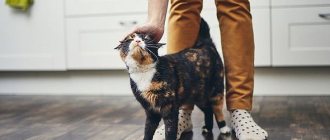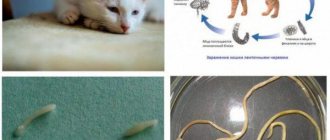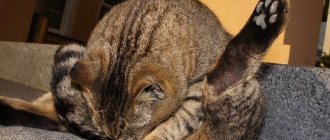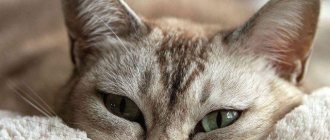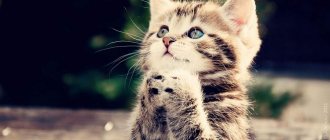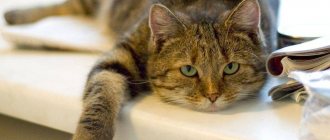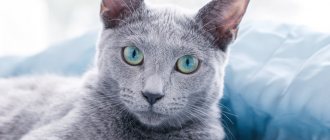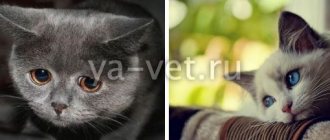Overweight in pets is a common problem that owners tend to underestimate. Against this background, dangerous diseases often develop, some of them irreversible. The sooner you think about how to help your cat lose weight, the greater its chances of a long and healthy life.
But in order to effectively combat the problem, it is important to understand its roots. Only by answering the question of why your cat is getting fat can you take the first step towards its recovery. We hope our article will help you with this.
The animal is overfed
Many owners simply pour dry food into a bowl and allow the pet to eat as much as it wants, adding more as it becomes empty. There is nothing wrong with this, because cats by their nature are not predisposed to overeating. But sometimes “the settings go wrong” and the animal loses its sense of proportion. The reasons for this may be different:
- experienced a period of hunger or malnutrition;
- excess carbohydrates in the diet (sudden surges in blood sugar spur appetite);
- food that is too tasty and difficult to stop eating;
- hormonal changes, taking certain medications.
Cats prone to obesity need to strictly ration the amount of food they eat. If you use ready-made complete food, there will be no difficulties with calculating the diet: all the necessary information is already on the packaging. On our foods it is presented in the form of a table, with a separate column for overweight cats.
When measuring food, you should use a branded cup or an accurate kitchen scale. Cat portions are very small, so even an error of 10–15 grams can interfere with weight loss. Also note that the indicated dosages are calculated per day, and not per feeding.
When feeding homemade food, the diet must be prepared individually. It is important to take into account not only the energy value, but also the distribution of macronutrients (proteins, fats, carbohydrates).
Rules for feeding castrated cats
Regardless of what type of food the cat receives (ready-made food, natural food), the pet’s diet should not only be varied and balanced in the content of nutrients, but also meet the energy needs of the animal.
Considering that after castration, the body’s energy needs are reduced by approximately 20-30%, it is necessary to reduce the calorie content and nutritional value of the diet. A castrated cat only needs 70-80% of the food he consumed before castration. Thus, you need to reduce portions or reduce the frequency of feedings. For example, if your cat is used to eating three times a day, switch your pet to two meals a day.
A castrated cat with a slow metabolism requires 60 kcal per kilogram of weight per day. If the cat is prone to obesity or suffers from endocrine pathologies, reduce this figure by 20-25%.
Before feeding your cat, to accurately calculate the serving size, use a measuring cup or kitchen scale, since the approximate dosage may be incorrect.
If your cat is accustomed to begging for treats and food, do not follow your pet’s lead. By encouraging your cat, you only make the situation worse. Divide the daily amount of feed into several meals. Give your cat food at the same time, stick to the routine. By dividing the daily diet into several portions, you can fully satisfy your cat’s needs without increasing the volume of food eaten.
Considering that castrated cats are often diagnosed with kidney stones, you can slightly acidify the food, unless of course there are contraindications. Give us kefir, low-fat cottage cheese, yoghurts, skim milk.
The cat is pampered with treats
Sometimes it’s not the food at all: it is given strictly according to the norms, but every time the cat visits the kitchen, she receives delicacies or treats from the owner’s table. If there are several household members and they eat at different times, the amount of food eaten by the animal cannot be controlled. Some foods that cats love have a fairly high energy value. Even a small piece of cheese, lard or sausage can be significant in the diet of an animal weighing 4–5 kg.
If you find it difficult to resist the attacks of a tailed beggar, simply keep him out of the kitchen during your own meals and snacks. Warn all family members that the cat is on a diet and should not receive anything other than the daily allowance of food. Otherwise, it will be difficult for your pet to lose weight.
My cat is obese: will diet help?
Against the background of increased physical activity, diet therapy is the only effective way to lose weight. No magical and safe diet pills have been invented - both for people and for cats. At the same time, unlike humans, cats are strictly contraindicated from starving, so the task becomes more difficult, but nevertheless it can be solved quite successfully.
It is best to consult a doctor and put the animal on a special veterinary diet, which is available in the range of some medicinal food brands. Such diets usually have the words Obesity or Overweight in their names.
They contain a reduced amount of fat (the main source of energy for carnivores), an average level of protein, but still sufficient to maintain muscle mass, and a large amount of fiber, which is not digested, contains no calories, but creates a feeling of satiety.
Also, such diets include a specially selected complex of vitamins and minerals, as well as additional substances that affect metabolism.
The whole day is spent on the couch
In the wild, cats eat as much as they can and don’t get fat. The fact is that they are simply forced to move, getting food for themselves. In addition, they are constantly in a hostile environment, where they have to flee from larger predators. During the winter season, a lot of energy is spent on heating the body, which further increases the overall calorie expenditure.
Of course, in a city apartment it’s impossible to repeat all this, and it’s not necessary, but spending the whole day on the sofa is also not a good idea for a healthy cat. Encourage her to move with interactive toys and teases. Some cats love to play with rubber mice and chase laser pointers. Others become active in the presence of a companion. Look for what suits you.
Difficulties and problems of fat cats
Numerous studies have shown that obesity can have detrimental effects on the health and longevity of dogs and cats. Here is just a small list of medical problems of fat cats, the connection of which with obesity has been scientifically proven:
- orthopedic diseases;
- diabetes;
- lipid metabolism disorders;
- heart disease;
- respiratory diseases;
- disorders of the urinary and reproductive systems;
- breast cancer;
- some types of transitional cell carcinoma;
- dermatological diseases.
Additionally, fat cats and dogs are at greater risk during anesthesia. As for life expectancy, so far reliable studies have been conducted only among dogs and have shown a decrease in life expectancy with obesity by an average of 2 years.
Wrong diet
Above, we briefly touched on the topic of carbohydrates in a cat’s diet. Now let's look at this in more detail. The truth is that in their natural habitat, representatives of the cat family practically do not eat plant food, except perhaps along with the entrails of a herbivorous prey. By offering a cat food that is half or even more carbohydrates, we are going against its nature. This sooner or later results in disturbances in the normal functioning of the body, one of which is obesity.
The Acana and Orijen diets are biologically appropriate. This means that they are as close as possible to the diet of animals in nature: a lot of protein, a moderate amount of fat, a minimum of carbohydrates. For cats prone to obesity, we have a special food - Orijen Fit & Trim. Its energy value is slightly reduced in comparison with other products in the line and amounts to 371 kcal per 100 g. At the same time, the body receives 47% of calories from protein, 36% from fat, 16% from carbohydrates. The latter are represented by legumes, vegetables and unsweetened fruits, which do not cause sudden surges in blood sugar and, consequently, health problems.
How to find out the amount of carbohydrates in food? Usually this indicator is not indicated in the guaranteed analysis, however, knowing the amount of protein, fat and energy value of the product, you can calculate it yourself. It is important to remember that 1 gram of protein provides 4 kcal, 1 gram of carbohydrates - 4 kcal, and 1 g of fat - as much as 9 kcal. Sometimes it is enough to simply analyze the list of ingredients: sources of carbohydrates should not be in the first three to five positions.
The cat is getting fat: why is this happening and what to do?
Normal, overweight, obesity - how to distinguish
The normal body weight of a pet depends on the breed, sex, age, nutrition, living conditions, heredity, as well as changes after castration or sterilization.
A healthy and fit uncastrated British cat weighs from five to eight kilograms, but the weight of neutered cats can reach 10 or even 12 kilograms. Kitties are more miniature: normal body weight for them ranges around three to four kilograms. But a sterilized cat can weigh up to seven kilograms.
How can you tell if your cat is overweight?
Feel your pet's ribs. With normal body weight, the subcutaneous fat layer is thin, the ribs can be easily felt. See how your client breathes when lying on her side. When the cat does not have weight problems, in this position every inhalation and exhalation is noticeable, the side rises and falls.
Hardly anyone knows your pet better than you. Obesity in cats does not appear out of the blue; the situation develops gradually. Therefore, if you notice a rounded silhouette, excessive appetite, and the scales hint at your cat being overweight, it’s time to take action.
Signs of obesity in cats include excessively large body contours and the absence of clear boundaries of the ribs and abdomen. Added to this is a waddling gait, like that of a duck. This gait can only occur in a pregnant or obese cat. Shortness of breath is already evidence that problems with the cardiovascular system begin against the background of obesity.
Overweight and obesity in cats increases the risk of diabetes, urolithiasis and other serious problems.
One problem - many reasons
Why might a cat become overweight? Let's list a few probable reasons.
- Sterilization or castration.
Often, after spaying or neutering, a pet becomes addicted to food. Therefore, after the procedure, the patient under the guidance of a veterinarian is transferred to special food for sterilized and neutered pets.
- Change of season.
During the cold season, the pet no longer runs and walks as much as in the summer, but eats the same amount. Unspent energy turns into excess weight.
- Stress.
A cat can “eat up” the stress associated with moving, trips to the veterinary clinic and other disturbing factors, and gain weight because of this.
Maybe there's a new pet in the house? The mustachioed tabby is worried that the kitten will bite into his food, so he tries to eat more. A zoopsychologist will help here. Pets need to be reconciled. You can try feeding them in different rooms.
- Changes in diet.
For example, adding wet food to the usual dry food, switching to natural feeding and other innovations in the diet. All this always provokes a change in appetite.
- Diseases.
It is possible that the pet leans on food due to illness of the gastrointestinal tract and digestive organs. Perhaps a disorder in some other organ system causes the pet to eat nonstop. Sometimes it happens that due to a head injury or damage to the nervous system, the pet does not feel or understand that it has already eaten.
We especially emphasize that an overweight or obese pet should first be shown to a veterinarian. You need to make sure that excess body weight is not caused by any disease. The struggle to keep your cat slim and graceful should definitely begin in the veterinarian’s office also because it is necessary to determine whether excess weight has caused health problems.
Taking nutrition seriously
The veterinarian will select a balanced, proper diet for the cat, taking into account its needs and health characteristics. Transfer your ward to a new food gradually, mixing the usual food and a therapeutic diet in a bowl for 10 days.
There are cases when cats are wary of medicated food, but then get used to it. And it also happens that the food still has to be changed, but the choice of line should be under the control of a veterinary specialist.
Make sure your cat drinks enough water.
Even a losing weight pet needs to eat every day. However, gradually reduce the daily portion of food and bring it up to the daily requirement specifically for your pet.
When feeding, keep in mind that the table for calculating food portions on the package is a fairly arbitrary guide. It is necessary to take into account the pet’s activity level, its age, and size. Discuss feeding rates with your veterinarian.
Many cat owners prefer to feed their mustachioed tabbies twice a day. A healthy cat without gastrointestinal problems normally tolerates such a feeding schedule. But veterinarians note that feeding five to six times a day in small portions is more consistent with the needs of cats.
If you are at home all day, then nothing will stop you from feeding your ward five or six times a day. For a cat who is not prone to overeating, you can feed him food for the whole day in the morning. Your pet will figure out on its own when it’s best for her to get some food. But if your cat has an excessive appetite and you are away from home all day, an automatic feeder may be the solution to the problem. The compartment with food in it opens at a certain time.
Exercise for cats
In nature, cats are dexterous predators that track prey, lie in wait for potential prey, and hunt. The speed of reaction determines whether the hunt will be successful. To feel good, domestic cats also need to satisfy their instincts, the need to hunt. And what good is it if a cat eats and sleeps all day? If you have two cats, they tend to play together, so they are less likely to become couch potatoes. But if there is only one pet, then the role of a personal fitness trainer will go to you.
All cats need outdoor games to maintain physical fitness and develop intelligence. Provide your pet with moderate but regular physical activity for at least 30-45 minutes a day. The easiest way to do this is through toys and games.
When it comes to cats and overweight cats, a treat fetch puzzle is a good choice. Such toys help your pet move more and eat less. The snack lasts a long time, because you need to roll the puzzle, literally fight for every piece of the treat. The cat develops ingenuity and feels like a real breadwinner.
All cats love teasing toys with feathers. A fun, active game will not only make your cat more active, but will also bring you closer together. You can also use a laser pointer: in a cheerful pursuit of the “red dot”, the extra grams will burn out very quickly.
If possible, install several high scratching posts at home, or even better, a cat city with tunnels and manholes at various levels. It’s unlikely that your cat will want to while away the time on the sofa when there’s such a jungle nearby!
The secret of health and a good figure for cats is simple: proper diet, sufficient physical activity, regular examinations by a veterinarian, love and care from the owners. We wish your pets well-being!
The animal has been spayed (neutered)
There is an opinion that weight problems begin after surgery to remove the gonads. But this does not mean that it is worth torturing the animal and tolerating its behavior during sexual hunting. You just need to take some preventive measures:
- feed the cat after sterilization strictly at the rate recommended by the food manufacturer;
- Weigh your pet weekly and record the result;
- if necessary, adjust the rate downwards.
Practice shows that with a normal diet and sufficient physical activity, most sterilized cats remain in good physical shape for many years. While with improper feeding and a sedentary lifestyle, even an animal with preserved reproductive function can quickly gain weight.
Castration of cats: indications for surgery
Castration is a simple surgical operation in which the gonads (testicles, testes) are removed from males. The main purpose of the operation is to deprive animals of reproductive function.
It is best to castrate cats after puberty, at the age of 8-10 months. Earlier castration can lead to serious complications and consequences, which often end in death. If you castrate a cat after the pet has already had contact with cats, the sexual instinct may remain, and the cat will continue to be interested in individuals of the opposite sex.
As a rule, veterinarians recommend castration for cats that are not of breeding value. Often cats are castrated after being removed from breeding, but as already noted, in this case castrated males may continue to show interest in cats.
Castration of cats is necessary:
- if the cat asks to go outside, constantly meows during the period of sexual heat;
- shows aggression during the rut;
- to prevent unwanted litters;
- leaves its marks in the house, apartment, entrance.
In some cases, the operation has medical indications (injuries of the scrotum, testes, cryptorchidism, congenital pathologies).
It is also worth noting that unneutered cats who do not have contact with cats can suffer from prostatitis. Such pets have an increased risk of developing urolithiasis.
Castrated animals live 65-70% longer than their non-castrated relatives. Viral and bacterial diseases and infections (herpes virus, chlamydia) are transmitted sexually.
In addition, if you constantly give males oral hormonal contraceptives, drugs to reduce sexual desire, or adjust behavior during the rut, the risk of developing tumors increases and hormonal levels are disrupted.
Neutered cats become calmer and, in rare cases, show aggression towards their relatives and family members.
The tendency to be overweight is determined by breed
We will not deny that some breeds are more prone to obesity than others. However, this is not a verdict, and everything is again in the hands of the owner. The cat gets fat not only because she is British, but also because she gets too much food. By eliminating the cause, you will get rid of the effect.
Please note that reversing obesity is much easier at the initial stage. If you see that your cat’s sides are rounded, and the spine and ribs are hard to feel under a layer of fat, you should reconsider its diet without waiting for it to turn into a ball.
Why is the cat fat?
Only a very small proportion of the causes of obesity are diseases (for example, hypothyroidism) or medications (for example, glucocorticoids and anticonvulsants) that cause increased appetite. Sometimes genetic defects lead to obesity, in particular, such defects have been recorded in the populations of certain breeds of dogs - Labrador Retriever, Cairn Terrier, Cavalier King Charles Spaniel, Cocker Spaniel and others, as well as in some breeds of cats.
An important risk factor is sterilization of animals, after which the metabolic rate decreases. However, studies show that if the main energy expenditure is on muscle activity, then there is no difference between castrated and non-castrated animals - the metabolic rate will be the same.
A much larger role is played by changes in eating behavior after sterilization: the cat eats a lot, gets fat, and moves less.
Fat cat - owner stereotypes
However, the most important cause of obesity is humans. Why is the cat fat? You are overfeeding him. Interestingly, the reason for overfeeding is different for dog and cat owners. In dogs, as in humans, eating and sharing food plays an important social role.
The animal always tries to be present at the family meal and, even if it is trained not to beg for pieces, the owner always, simply at the genetic level, has a desire to treat the dog. Everyone should eat!
In addition, many people like to watch a dog eat: expressive facial expressions allow these animals to demonstrate obvious and great pleasure from the process. And this, in turn, pleases the owner. It is not for nothing that we are pleased to watch people and children with a good appetite eat.
In cats, food has no social function. But man is a social animal, so he unwittingly misinterprets the animal’s signals. The cat meows, asking for communication, and the person, especially if he is preparing or eating food at this time, thinks that she is asking for food. Well, how can you not give a piece! At the same time, the cat understands that seeking contact with a person leads to food reinforcement, and this makes it initiate it as often as possible.
As for diet, scientists have not found any connection between obesity and feeding homemade natural food (not food from your table!) or industrial diets. But there is an important “but”: the cheaper, lower quality both are, the higher the risk of obesity.
A logical factor why a cat is fat is the owner’s excess weight: a person who overeats himself and is not used to thinking about the volume and calorie content of the food he absorbs does not bother with this issue in relation to his animal.
The pet is seriously ill
Rarely, there are situations when weight gain is caused by diseases that require immediate treatment. The specific cause here is difficult to determine only by external signs: consultation with a veterinarian and a full examination are necessary.
Fasting is contraindicated for cats! The daily norm can be reduced by a maximum of 10–20% and it is better to do this gradually, monitoring the pet, especially if it has any health problems. If, despite your best efforts, the weight does not decrease, it is wise to consult a veterinarian.
Features and symptoms of the disease
High greasiness of the coat is a disease that most often affects unneutered cats. True, it can also appear in pets that have been castrated, but much less frequently. The main cause of oily fur on a cat's back, tail, or other parts of a fluffy's body is a pathology called perianal gland hyperplasia. Sebaceous secretions accumulate on the skin in excess. From there it gets onto the animal's fur, severely polluting it.
The symptoms of greasy coat syndrome are as follows::
- Oily hair appears at the base of the cat's tail, back or sides;
- the pet’s “fur coat” becomes dull and sticks together into tangles;
- on the pet’s skin a wax-like composition that has a brownish color and exudes a rancid odor;
- the skin in those areas where there is greasy hair becomes inflamed and red;
- often weakened and matted hair falls out;
- Scabs appear on the surface of the skin;
- the hair follicles become inflamed, and then many small pimples appear in their place.
© shutterstock
If the disease becomes chronic, the area of the body with damaged hair may become completely bald. The appearance of scabs on the skin leads to the unfortunate cat developing eczema.
